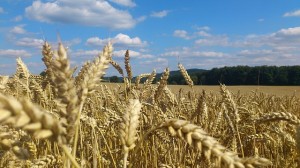13
Jan
Monsanto Once Again Developing Herbicide Resistant Wheat
(Beyond Pesticides, January 13, 2015) Over a decade after consumer opposition halted multinational agrichemical business Monsanto’s plans to develop genetically engineered (GE) herbicide-resistant wheat, the company is trying again. This time, Monsanto’s goal is to create wheat that is resistant to three different herbicides; glyphosate, glufosinate, and dicamba. Although over 90% of corn, soybean, and cotton grown in the United States are GE, no GE wheat is currently allowed to be planted.
 In 2013, a farmer in Oregon discovered the presence of Monsanto’s original Roundup-Ready wheat, developed to be resistant to glyphosate, in his field despite the company’s plans to abandon the strain and claims to have destroyed the crop a decade earlier. The company had restarted extensive field trials back in 2011. An investigation by the U.S. Department of Agriculture (USDA) determined that the contamination was an “isolated incident.” It was unable to determine exactly how the wheat came to grow in the Oregon farmer’s field.
In 2013, a farmer in Oregon discovered the presence of Monsanto’s original Roundup-Ready wheat, developed to be resistant to glyphosate, in his field despite the company’s plans to abandon the strain and claims to have destroyed the crop a decade earlier. The company had restarted extensive field trials back in 2011. An investigation by the U.S. Department of Agriculture (USDA) determined that the contamination was an “isolated incident.” It was unable to determine exactly how the wheat came to grow in the Oregon farmer’s field.
However, shortly after the agency closed its investigation, another farmer in Montana detected the GE strain in his wheat fields. The recurrence of this incident reveals the contamination event not to be an isolated incident. It instead demonstrates the threat that these crops pose to farmers and the environment, as well as the government’s failure to recognize the pervasive and persistent nature of GE contamination.
In 2012, U.S. wheat exports were valued at $18.1 billion. Contamination events can cause significant economic harm to individual farmers, and even damage entire industries. Over 60 countries have bans on the production and import of GE crops. In response to the 2013 incident in Oregon, countries around the world, including Japan, South Korea, and the entire EU, enacted detrimental restrictions on the import of wheat.
In response to these trade barriers, wheat farmers in the Pacific Northwest launched a lawsuit against Monsanto. In November of last year, not wishing to engage in an extended legal battle with the growers, Monsanto announced a $2.4 million settlement.
In its intent to incorporate three levels of herbicide tolerance, Monsanto’s new variety of wheat recognizes the failures of its Roundup-Ready farming system. Since such varieties were developed, weeds throughout the U.S. have displayed resistance to the company’s flagship glyphosate-based herbicide Roundup. A study published in 2012 by Washington State University researcher Charles Benbrook, PhD, found that, rather than decrease herbicide use as chemical companies like Monsanto originally claimed, herbicide-tolerant cropping systems increased herbicide use from 1.5 million pounds in 1999 to roughly 90 million pounds in 2011. “Resistant weeds have become a major problem for many farmers reliant on GE crops, and are now driving up the volume of herbicide needed each year by about 25 percent,” Dr. Benbrook said.
In response to widespread resistance, agrichemical companies have doubled-down and engineered new varieties of GE crops resistant to increasingly toxic herbicides. And regulators in USDA and the Environmental Protection Agency (EPA) have rubber-stamped these harmful products. In October of last year EPA approved a new herbicide to be used on a new form of corn resistant to 2,4-D and glyphosate, despite outcries from public health and environmental advocates.
As it stands, Monsanto has gained USDA approval on cotton and soybean plants tolerant of dicamba, and is waiting on regulatory decision from EPA on the “Xtend” herbicide that complements the crop. Increased use of dicamba is certain to induce dicamba-resistant weeds, similar to what is currently seen with Roundup. As a result of dicamba’s high mobility in soils, contamination of groundwater is a significant risk. Dicamba has a high tendency to vaporize and drift, resulting in injury to sensitive crops. Abnormal leaf growth and floral development, reduced yield, and reduced quality have all been observed from dicamba drift. Moreover, studies have found that exposure to dicamba prior to conception is associated with increased risk of birth defects in male offspring. Dicamba has also been associated with a decrease in the ability to conceive, and cell death in developing embryos.
Contrary to industry proclamations, introducing wheat engineered to tolerate dicamba, glufosinate, and glyphosate will only keep farmers on a chemical treadmill that continues to propagate resistant weeds, endanger the environment, health, and agricultural economy.
For more information on the hazards associated with GE technology, visit Beyond Pesticides’ Genetic Engineering webpage. The best way to avoid genetically engineered foods in the marketplace is to purchase foods that have the USDA certified organic seal. Under organic certification standards, genetically modified organisms and their byproducts are prohibited. For many other reasons, organic products are the right choice for consumers.
Source: St. Louis Post-Dispatch
All unattributed positions and opinions in this piece are those of Beyond Pesticides.











Ebay is a good place to get non-GMO and generic food at good prices. A good deal for both the farmers and buyers.
January 29th, 2015 at 12:32 pm